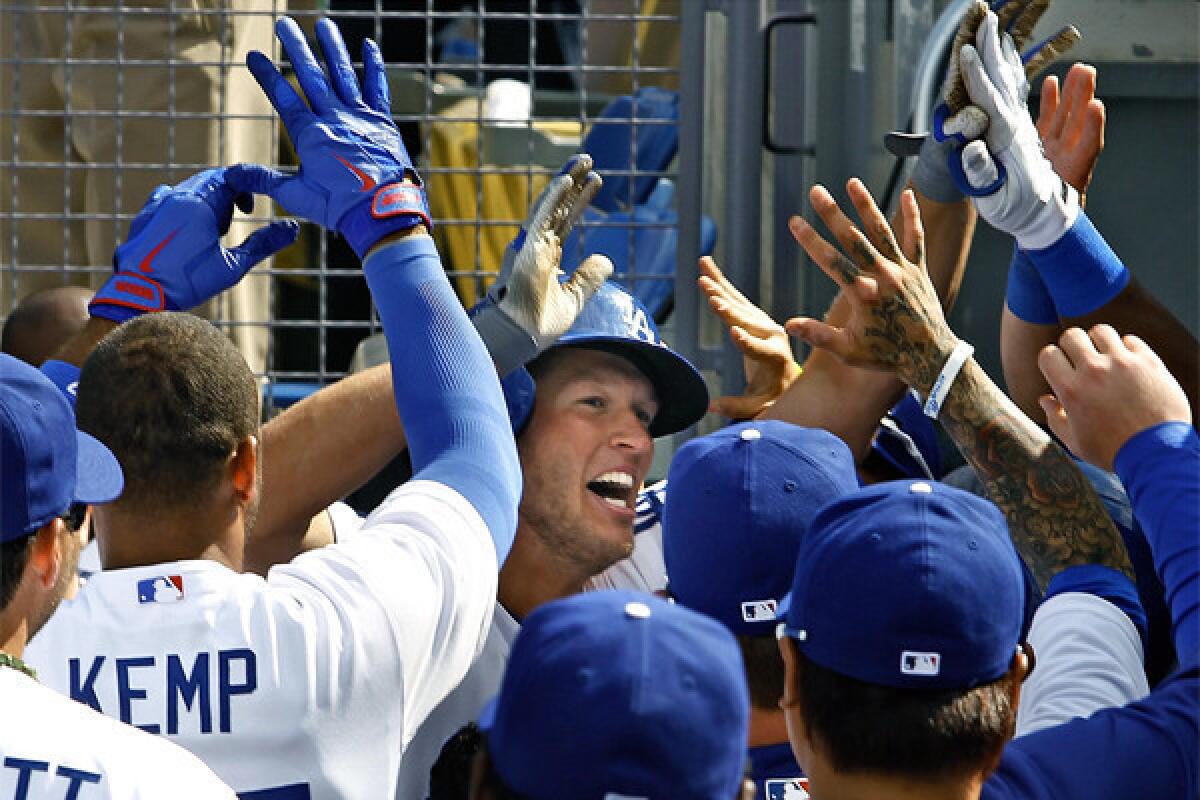There’s no need for a designated hitter in the National League — ever

- Share via
The memories could last a lifetime. You could tell the kids, and the grandkids, about the tingles in the Dodgers’ season opener.
Sandy Koufax shyly emerged from the dugout to throw out the first pitch, serenaded and beloved. Clayton Kershaw dominated on the mound, as unhittable today as Koufax was in his day.
Yet, Dodger Stadium did not erupt into bedlam until the eighth inning, when Kershaw ended a scoreless tie by launching a home run that instantly became part of Dodgers lore.
“Pretty stirring,” Dodgers General Manager Ned Colletti said.
Here come the killjoys, lobbying to eliminate the possibility of any such magic ever again. The start of the season, the first with interleague play every day, brought forth a new wave of calls for the National League to surrender its tradition and adopt the designated hitter.
Should the NL confiscate the bats of its pitchers so both leagues can play by the same rules? We’ll take up that issue in a moment, but first: among those who could change the rules, there is no momentum to do so.
Joe Torre, the executive vice president who handles on-field matters for Commissioner Bud Selig, said the issue has not come up in the commissioner’s office. Angels Manager Mike Scioscia, who serves on the Major League Baseball committee that would discuss the issue, said it has not come before the committee.
Colletti said the general managers have not debated the issue. Neither has the players’ union, according to Executive Director Michael Weiner.
The current collective bargaining agreement, in force through the 2016 season, calls for up to 20 interleague games per year. The agreement specifies that the designated hitter “shall be used” for interleague games in American League ballparks and “shall not be used” for interleague games in NL parks.
In the bargaining talks, Weiner said, the players were much more interested in minimizing the number of interleague games than they were in standardizing the rules. At one point, the owners had proposed about 30 interleague games.
The greater the number of games between the leagues, the greater the potential effect on teams assembled under the rules of their own league.
The Angels, for instance, put together a fly-ball pitching staff, under the premise that Mike Trout and Peter Bourjos could run down just about any fly ball. Then they opened the season in Cincinnati, where Scioscia benched Bourjos so the Angels could keep Mark Trumbo’s bat in the lineup.
If owners and players were to agree on one set of rules, the designated hitter would come to the NL, just as it has to the minor leagues and to virtually every other professional league in the world.
“For the baseball purists who say, ‘Just get rid of the DH,’ I don’t see that happening,” Scioscia said.
This is about contracts, but not the short-term ones signed by the likes of David Ortiz of the Boston Red Sox or Lance Berkman of the Texas Rangers. The designated hitter, originally intended to prolong the career of an aging slugger, has evolved into a position that gives managers flexibility with players needing to ease back from an injury or take a “half-day off” by batting but not fielding. Of the 14 AL clubs last year, only five had a DH with as many as 500 plate appearances.
No, the contract issue here is a long-term one. The Angels might not sign Albert Pujols for 10 years, and the Detroit Tigers might not sign Prince Fielder for nine, without the DH option.
“It’s more likely the American League team would sign a player like that knowing the DH is available to him at the end of his career,” Weiner said. “You would think a National League team would have to think twice about that.”
At first glance, that is a significant competitive advantage for the AL. In reality, not so much, not as bans on steroids and amphetamines make teams increasingly wary of locking up players into their late 30s and 40s.
Scioscia thought the DH minimized strategy, until he became the Angels’ manager. He discovered that the NL had become predictable — bunt with the pitcher up, or do not bunt because the pitcher is due up, rather than bunt when the strategy appears most logical.
“There is more of a chance to play little ball in the American League than there is in the National League,” Scioscia said. “You can do it through your whole lineup.
“It’s ironic. Everybody thinks this is the slow-pitch league.”
As the DH becomes less of a one-dimensional side show, and as strategies become common among the leagues, the urgency to standardize the rules tends to dissipate.
“Right now, I think everybody is fine with the status quo,” Weiner said. “One league does it one way, the other league does it the other way, and you fight about it in bars and restaurants.”
And Kershaw hits, the loudest and most joyous of sounds in the soundtrack of opening day.
twitter.com/BillShaikin
More to Read
Go beyond the scoreboard
Get the latest on L.A.'s teams in the daily Sports Report newsletter.
You may occasionally receive promotional content from the Los Angeles Times.











